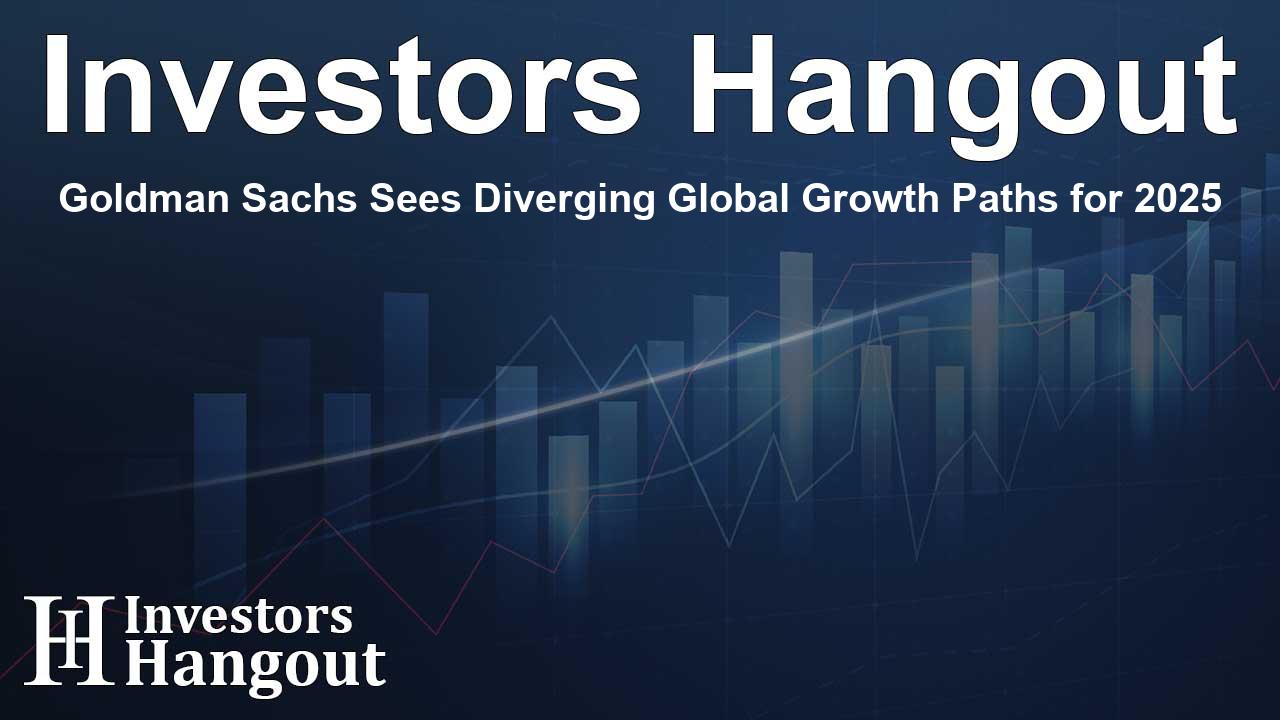Goldman Sachs Sees Diverging Global Growth Paths for 2025

Goldman Sachs' Economic Forecast for 2025
Goldman Sachs has made notable predictions for the global economy in 2025, focusing on easing financial conditions and geopolitical uncertainties that could shape the year's performance. The investment giant anticipates a varied growth path for significant economies including the US, Euro area, and China, where the US is projected to outperform its counterparts.
Global GDP Growth Expectations
According to Goldman Sachs, global real GDP growth is set to achieve a solid rate of 2.7% year-over-year in 2025. This growth is expected to be driven by increases in real disposable household incomes alongside loosening financial conditions. The bank emphasizes that rate cuts will play a crucial role in this outlook, noting that US growth is poised to surpass that of its developed market peers, thanks to strong productivity growth.
Key Factors Influencing Growth
The report underscores that core inflation is slated to return to targeted levels across developed markets by the end of 2025, complementing the positive growth forecast.
US Economic Landscape
Goldman Sachs anticipates above-consensus US GDP growth at 2.4% for 2025. This optimistic outlook is grounded in robust income growth along with financial easing within the economy. The forecast for core PCE inflation indicates a decrease to 2.4% by December 2025, resulting from decreased shelter inflation and easing wage pressures, albeit with some impact from heightened tariffs.
Unemployment Trends
In addition, the bank projects a slight decline in the unemployment rate to about 4% by the end of the year, reflecting positive labor market conditions.
Federal Reserve Rate Cuts Anticipated
The Federal Reserve is expected to implement three rate cuts during 2025, beginning with an initial 25 basis points reduction in March, followed by cuts in June and September. This would reposition the terminal rate between 3.5% and 3.75%. Furthermore, Goldman Sachs foresees the Fed tapering its balance sheet runoff, expected to conclude by the second quarter of 2025.
Outlook for the Euro Area
Turning to the Euro area, Goldman Sachs forecasts a below-consensus GDP growth rate of 0.8%. This anticipated stagnation is attributed to persistent structural challenges within the manufacturing sector, including high energy costs and competitive pressures from China. The impact of fiscal tightening and trade policy uncertainties are also anticipated to hinder growth.
Inflation in the Euro Area
Inflation is expected to stabilize around 2% by year-end, coinciding with a gradual cooling in services inflation.
European Central Bank's Rate Strategy
Goldman Sachs projects that the European Central Bank (ECB) will adopt a strategy of sequential 25 basis points rate cuts, reducing the policy rate to 1.75% by July 2025. However, the bank highlights potential risks, warning that deeper cuts might be needed if both growth and inflation experience further deterioration.
China's Economic Slowdown Forecasted
In China, the bank predicts a real GDP growth contraction to 4.5% in 2025. This slowdown stems from ineffective policy easing while domestic consumption and property markets struggle under high tariffs imposed by the US. The long-term outlook suggests continued caution regarding China's growth prospects due to structural challenges, including a declining demographic trend and extensive debt deleveraging.
Geopolitical Risks
Lastly, Goldman Sachs emphasizes the importance of staying attuned to US policy changes and geopolitical developments, particularly in the event that Donald Trump regains the presidency. Potential risks involve increased tariffs on both China and the auto industry, shifts in immigration policy, tax reductions, and regulatory adjustments. While tax cuts may incentivize growth, the anticipated economic headwinds from higher tariffs could offset these benefits, significantly impacting Europe and China.
Frequently Asked Questions
What are Goldman Sachs' key predictions for global GDP in 2025?
Goldman Sachs projects a global real GDP growth of 2.7% for 2025, driven by rising disposable incomes and relaxed financial conditions.
How does Goldman Sachs view the US economic outlook for 2025?
Goldman forecasts a US GDP growth of 2.4% and a reduction in core PCE inflation to 2.4% by the end of 2025.
What actions is the Federal Reserve likely to take in 2025?
The Federal Reserve is expected to implement three rate cuts, beginning with a 25 basis points cut in March, reducing the terminal rate to 3.5-3.75%.
What challenges does the Euro area face according to Goldman Sachs?
The Euro area is projected to see GDP growth of only 0.8%, hindered by high energy prices and trade uncertainties.
What is the forecast for China's economy in 2025?
Goldman Sachs predicts a slowdown in China's economic growth to 4.5%, influenced by poor domestic consumption and substantial policy challenges.
About Investors Hangout
Investors Hangout is a leading online stock forum for financial discussion and learning, offering a wide range of free tools and resources. It draws in traders of all levels, who exchange market knowledge, investigate trading tactics, and keep an eye on industry developments in real time. Featuring financial articles, stock message boards, quotes, charts, company profiles, and live news updates. Through cooperative learning and a wealth of informational resources, it helps users from novices creating their first portfolios to experts honing their techniques. Join Investors Hangout today: https://investorshangout.com/
Disclaimer: The content of this article is solely for general informational purposes only; it does not represent legal, financial, or investment advice. Investors Hangout does not offer financial advice; the author is not a licensed financial advisor. Consult a qualified advisor before making any financial or investment decisions based on this article. The author's interpretation of publicly available data shapes the opinions presented here; as a result, they should not be taken as advice to purchase, sell, or hold any securities mentioned or any other investments. The author does not guarantee the accuracy, completeness, or timeliness of any material, providing it "as is." Information and market conditions may change; past performance is not indicative of future outcomes. If any of the material offered here is inaccurate, please contact us for corrections.